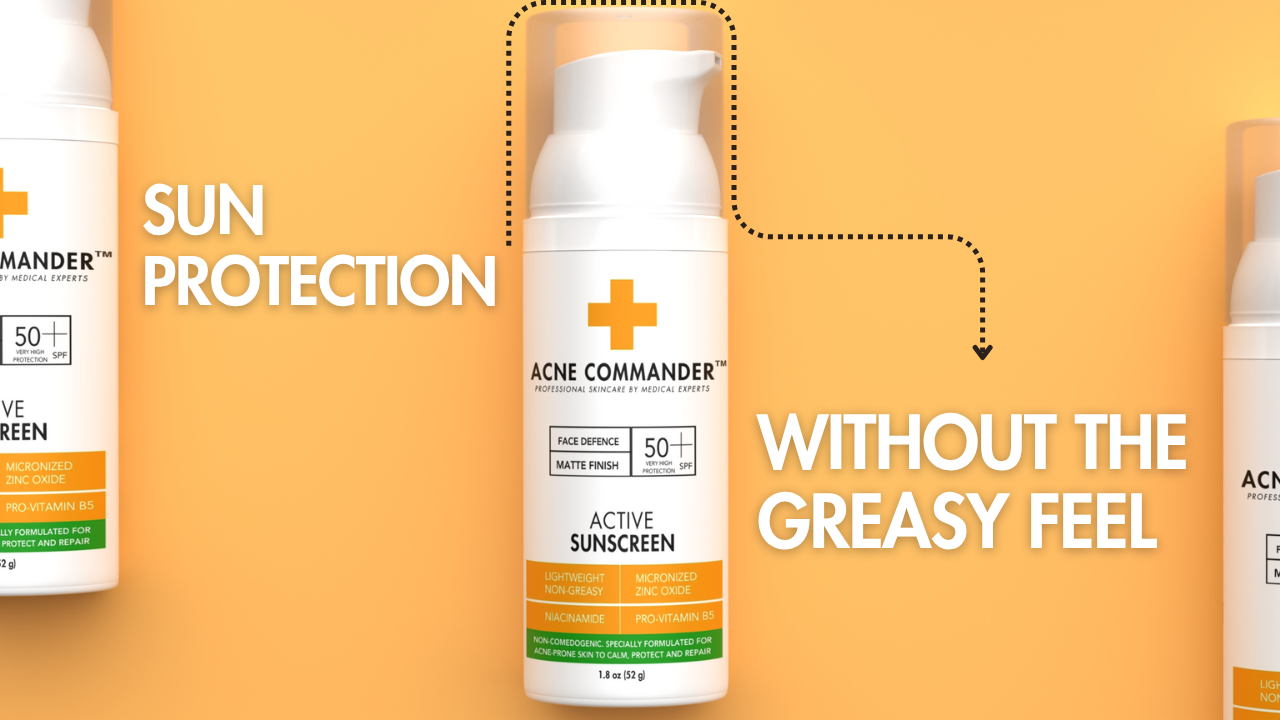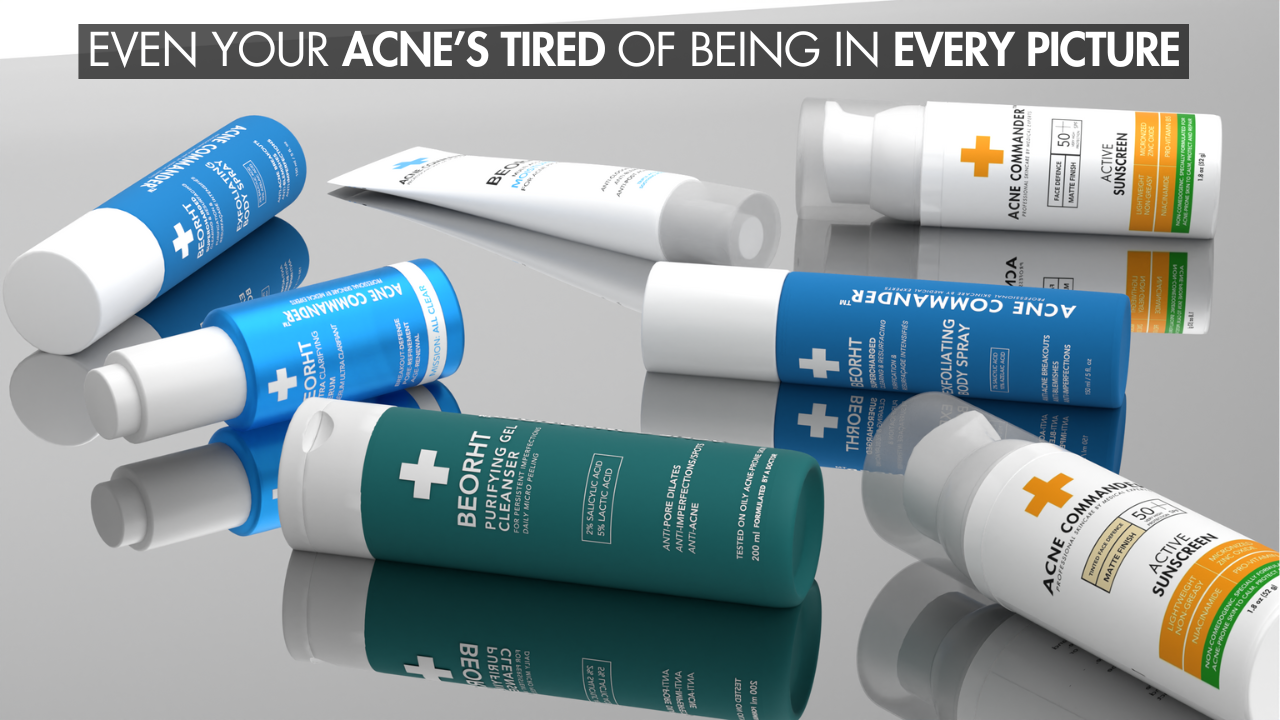Introduction
Exfoliation is an essential part of a skincare routine, especially for individuals with acne-prone skin. Salicylic Acid, a beta hydroxy acid (BHA), is one of the most popular and effective exfoliating ingredients for treating acne, preventing clogged pores, and promoting clearer, smoother skin. But how does Salicylic Acid exfoliate the skin, and what makes it so effective at addressing acne and other skin concerns?
In this article, we’ll dive into how Salicylic Acid works as an exfoliant, its benefits for skin health, and why it’s particularly beneficial for acne treatment. We’ll also highlight Acne Commander’s Beorht Purifying Gel Cleanser, which contains Salicylic Acid, as an effective skincare solution for exfoliating and preventing acne.
What Is Salicylic Acid?
Salicylic Acid is a type of beta hydroxy acid (BHA), which is a class of exfoliating acids that are oil-soluble. Unlike alpha hydroxy acids (AHAs) like Glycolic Acid, which are water-soluble, BHAs like Salicylic Acid can penetrate deeper into the pores, making them especially effective for acne-prone skin.
Salicylic Acid is derived from willow bark and has been used for centuries for its anti-inflammatory and exfoliating properties. In skincare, it’s known for its ability to exfoliate the skin, reduce acne, and improve skin texture by targeting the deeper layers of the skin. It is commonly found in acne treatments, cleansers, toners, serums, and masks.
How Does Salicylic Acid Exfoliate the Skin?
Salicylic Acid works as an exfoliant by helping to remove dead skin cells from the surface of the skin, as well as deep within the pores. Here’s how it exfoliates:
1. Penetrates Deep into the Pores
One of the key benefits of Salicylic Acid is its ability to penetrate deep into the pores. Since Salicylic Acid is oil-soluble, it can reach the deeper layers of the skin, breaking down the buildup of oil, dead skin cells, and other impurities inside the pores. This deep penetration helps to unclog pores, which is the primary cause of acne. Clogged pores trap oil and bacteria, leading to breakouts, and Salicylic Acid works to clear them out from the inside.
2. Dissolves Dead Skin Cells
Salicylic Acid works by dissolving the bonds between dead skin cells on the surface of the skin. The exfoliation process involves the acid breaking down the keratin that holds these dead cells together. By gently removing the dead skin cells from the skin’s surface, Salicylic Acid helps reveal fresh, new skin underneath. This exfoliation process improves the overall texture and tone of the skin, giving it a smoother and brighter appearance.
3. Reduces Clogged Pores and Prevents Breakouts
The buildup of dead skin cells, oil, and debris in the pores leads to the formation of comedones (blackheads and whiteheads). By removing dead skin cells and breaking down excess oil inside the pores, Salicylic Acid helps prevent clogged pores, which reduces the likelihood of breakouts. Regular exfoliation with Salicylic Acid helps keep the pores clear, preventing acne from forming.
4. Anti-Inflammatory Action
Salicylic Acid has anti-inflammatory properties, which help calm irritated skin and reduce the redness and swelling often associated with acne. Acne, especially inflamed pimples, can cause the skin to become irritated and swollen. By reducing inflammation, Salicylic Acid helps to minimize the appearance of breakouts and promotes faster healing.
Benefits of Using Salicylic Acid as an Exfoliant
Salicylic Acid offers several benefits, especially for those with acne-prone or oily skin. Here’s why it’s so effective:
1. Deep Cleansing of the Pores
The ability of Salicylic Acid to penetrate deep into the pores and break down the oil and dead skin cells makes it especially effective for treating acne. By keeping the pores clear and free of debris, Salicylic Acid prevents the formation of comedones (blackheads and whiteheads) and helps to reduce acne breakouts.
2. Helps Treat and Prevent Acne
Salicylic Acid is one of the most effective treatments for active acne. By exfoliating the skin and clearing out clogged pores, it helps prevent new breakouts from forming. It also targets existing acne lesions, reducing inflammation, and promoting faster healing.
3. Improves Skin Texture and Tone
Exfoliating with Salicylic Acid helps improve the overall texture of the skin by removing dead skin cells that can make the skin appear dull and rough. Regular exfoliation helps promote cell turnover, giving the skin a smoother, more even appearance. It also helps fade hyperpigmentation or dark spots left behind by previous acne breakouts.
4. Reduces Acne Scarring
Salicylic Acid can help fade acne scars by promoting skin cell turnover. As it removes the outer layer of dead skin cells, new skin cells are exposed, helping to improve skin texture and reduce the appearance of acne scars over time. Salicylic Acid also helps prevent future acne, which helps reduce the chances of new scarring.
5. Calms Inflammation and Redness
Salicylic Acid’s anti-inflammatory properties help soothe inflamed, irritated skin. This is especially beneficial for individuals with inflamed acne or cystic acne, which often causes swelling and redness. By reducing inflammation, Salicylic Acid helps calm the skin and make acne less noticeable.
How to Use Salicylic Acid for Exfoliation
To get the most out of Salicylic Acid as an exfoliant, it’s essential to use it correctly. Here’s how to incorporate Salicylic Acid into your skincare routine:
1. Start with a Cleanser Containing Salicylic Acid
Use a Salicylic Acid-based cleanser like Acne Commander’s Beorht Purifying Gel Cleanser, which contains Salicylic Acid 2%. Apply the cleanser to damp skin, gently massaging it in circular motions for 30-60 seconds. This allows the Salicylic Acid to penetrate the pores and begin the exfoliation process.
2. Apply a Salicylic Acid Toner or Treatment
After cleansing, use a Salicylic Acid toner or treatment serum to further exfoliate and treat acne. Apply the product evenly to your skin using a cotton pad or your fingertips. Be sure to avoid the sensitive areas around the eyes and mouth.
3. Follow Up with Moisturizer
Salicylic Acid can be drying, so always follow up with a non-comedogenic moisturizer to keep your skin hydrated and balanced. Look for a moisturizer that is oil-free and won’t clog your pores, ensuring that the skin remains moisturized without contributing to acne.
4. Use Sunscreen
Since Salicylic Acid can increase your skin’s sensitivity to the sun, it’s important to wear sunscreen every day. Choose a broad-spectrum sunscreen with SPF 30 or higher and apply it in the morning, even on cloudy days. Sunscreen helps protect your skin from harmful UV rays and prevents pigmentation from worsening.
Beorht Purifying Gel Cleanser: A Great Option for Exfoliation and Acne Treatment
Acne Commander’s Beorht Purifying Gel Cleanser is an excellent choice for those looking to use Salicylic Acid to exfoliate and treat acne. Here’s why it’s ideal for this purpose:
Salicylic Acid 2%: Salicylic Acid works to exfoliate the skin, clear pores, and reduce acne by removing dead skin cells and excess oil.
Lactic Acid 5%: Lactic Acid gently exfoliates the skin’s surface, improving skin texture and helping to fade acne scars over time.
Non-Comedogenic Formula: Beorht Purifying Gel Cleanser is designed to be non-comedogenic, meaning it won’t clog pores or contribute to acne.
Soothing Plant Extracts: Scutellaria Baicalensis Root Extract and Sophora Angustifolia Root Extract help reduce inflammation and calm irritated skin.
Hydrating Ingredients: Sodium PCA and Butylene Glycol help maintain hydration, preventing dryness and irritation while treating acne.
Explore detailed information for Acne Commander's Beorht Purifying Gel Cleanser. Click Here
FAQ
Q1: How does Salicylic Acid exfoliate the skin?
Salicylic Acid exfoliates the skin by penetrating deep into the pores to dissolve dead skin cells, oil, and debris. It also removes the outer layer of dead skin cells, promoting skin cell turnover and improving texture.
Q2: Can Salicylic Acid help with acne scars?
Yes, Salicylic Acid helps improve skin texture and fade acne scars by promoting cell turnover and exfoliating the skin. Regular use can help reduce the appearance of post-acne scars over time.
Q3: Is Salicylic Acid safe for sensitive skin?
While Salicylic Acid is generally safe for most skin types, sensitive skin may need to start with a lower concentration (around 0.5% to 2%) to avoid irritation. Always patch-test new products before use.
Q4: How often should I use Salicylic Acid for exfoliation?
Start by using Salicylic Acid 2-3 times a week and gradually increase to daily use as your skin builds tolerance. Overuse can cause dryness or irritation, so listen to your skin’s needs.
Q5: Can Salicylic Acid be used with other exfoliating acids?
Yes, but be cautious not to over-exfoliate. Using Salicylic Acid with other exfoliating acids like Glycolic Acid can lead to irritation. Start with one exfoliating product and gradually introduce others.
Q6: Does Beorht Purifying Gel Cleanser help with acne?
Yes, Beorht Purifying Gel Cleanser contains Salicylic Acid and Lactic Acid, which help treat acne by exfoliating the skin, clearing pores, and preventing future breakouts.
Conclusion
Salicylic Acid is one of the most effective exfoliants for acne-prone skin. By breaking down dead skin cells, unclogging pores, and reducing inflammation, Salicylic Acid helps improve skin texture, prevent breakouts, and fade acne scars. Regular use of Salicylic Acid cleansers like Beorht Purifying Gel Cleanser provides deep exfoliation while being gentle on the skin, making it an ideal solution for clearer, smoother skin.
Call to Action: Ready to exfoliate and clear your skin? Try Acne Commander’s Beorht Purifying Gel Cleanser today and experience the benefits of Salicylic Acid for acne treatment!






